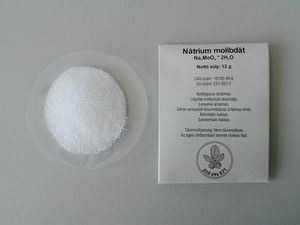Sodium molybdate
 Sodium molybdate crystals and original package
| |
| Names | |
|---|---|
| IUPAC name
Sodium molybdate
| |
| Other names
Disodium molybdate
Disodium tetraoxomolybdate Sodium molybdate(VI) Sodium orthomolybdate | |
| Properties | |
| Na2MoO4(anhydrous) Na2MoO4·2H2O (dihydrate) | |
| Molar mass | 205.92 g/mol (anhydrous) 241.95 g/mol (dihydrate) |
| Appearance | White solid |
| Odor | Odorless |
| Density | 3.78 g/cm3 |
| Melting point | 687 °C (1,269 °F; 960 K) |
| Boiling point | Decomposes |
| 84 g/100 ml (100 °C) | |
| Solubility | Insoluble in hydrocarbons |
| Vapor pressure | ~0 mmHg |
| Hazards | |
| Safety data sheet | Sigma-Aldrich |
| Flash point | Non-flammable |
| Lethal dose or concentration (LD, LC): | |
| LD50 (Median dose)
|
4,000 mg/kg (rat, oral) |
| LC50 (Median concentration)
|
>2,080 mg/m3 (rat, 4 hr) |
| Related compounds | |
| Related compounds
|
Ammonium heptamolybdate |
| Except where otherwise noted, data are given for materials in their standard state (at 25 °C [77 °F], 100 kPa). | |
| Infobox references | |
Sodium molybdate (Na2MoO4) is chemical compound, useful as a readily source of molybdenum. It is often encountered as the dihydrate form Na2MoO4·2H2O.
Contents
[hide]Properties
Chemical
Sodium molybdate will react energetically with interhalogens (bromine pentafluoride, chlorine trifluoride, etc.).
Its reaction with hot sodium, potassium or lithium is incandescent and violent.
When reacted with sodium borohydride, molybdenum is reduced to a lower valent oxide:[1]
- Na2MoO4 + NaBH4 + 2 H2O → NaBO2 + MoO2 + 2 NaOH + 3 H2
Physical
Sodium molybdate is a white crystalline solid, soluble in water, but insoluble in most organic solvents.
Availability
Sodium molybdate is sold as fertilizer for plants, and is available at many gardening stores, though it's a bit more expensive than most common fertilizers.
It can also be purchased from lab suppliers, online.
Preparation
Sodium molybdate can be prepared by dissolving MoO3 in an aq. solution of sodium hydroxide, at 50–70 °C and crystallizing the filtered product from the solution.
- MoO3 + 2 NaOH + H2O → Na2MoO4·2H2O
The anhydrous salt is prepared by heating the dihydrate to 100 °C.
Projects
- Source of molybdenum
- Fertilizer
Handling
Safety
Sodium molybdate has low toxicity. Inhalation may cause irritation of nose and lungs.
Sodium molybdate will react extremely violent and may even explode with many molten metals, like magnesium, alkali metals.
Storage
In closed bottles
Disposal
No special disposal is required.
References
- Jump up ↑ Chi Fo Tsang and Arumugam Manthiram. Journal of Materials Chemistry 1997. 7(6). 1003–1006.